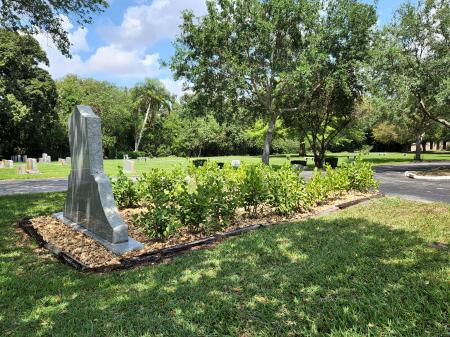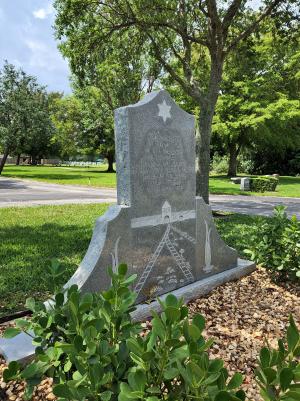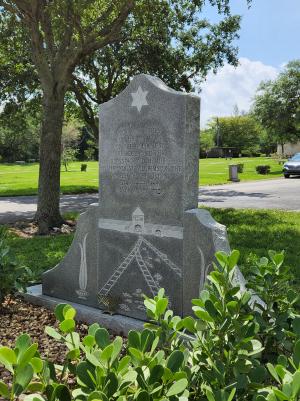Obj. ID: 44811
Jewish Funerary Art Holocaust memorial in Menorah Gardens Cemetery in Southwest Ranches, FL, USA, 2008
To the main object: Menorah Gardens Cemetery in Southwest Ranches, FL, USA

Who is Commemorated?
Martyrs of the Holocaust
Description:
The monument consists of a rectangular plot in the center of a roadway that leads from the cemetery entrance to the main area of burials. Though not big, it cannot be missed by anyone coming to the cemetery. The ground of the plot is covered with pebbles and lined on the sides with low shrubs. At the end stands a stone monument made of four pieces of gray granite. A long slab lies flat on the ground as a base. Centered on this is an almost rectangular upright slab, that peaks at the top. Flanking the central slab, and seeming to support it, are two roughly triangular brackets or “book ends,” with scalloped edges. Each side slab is inscribed with the image of an oil lamp with a tall flame.
The front of the central slab has three elements. A Magen David decorated the top, fitting into the peak upper edge of the stone. Beneath this is a nine-line commemorative inscription in English, except for the Hebrew word “Zachor.” Beneath the text and filling just under half of the front of the slab, is an inscribed image of the entrance to Birkenau, with railroad tracks and the entrance gate.
Inscription
SOIL AND ASHES
OF THE MARTYRS
OF THE HOLOCAUST
ARE RECLAIMED FOR
BLESSING AND MEMORY
BY THE YOUNG PILGRIMS OF THE
MARCH OF THE LIVING
5748 ---- 1988
NEVER AGAIN זכור
sub-set tree:
| 21100 Griffin Rd, Southwest Ranches, FL 33332
And 142” (360.7 cm) wide.
The width of the base of the monument in 121.5” (308.6 cm)
The central inscribed slab is 78” (198 cm) high, 35.5” (90.2 cm) wide
The memorial monument was created after 1988, apparently by participants in the first March of the Living that year. According to the inscription, soli and ashes were brough back from death camps were buried here. Officially the removal of any materials from Auschwitz and other sites was forbidden by the March organizers and Polish authorities. But in the 1980s and even continuing well into the 1990s, travelers regularly collected items as religious relics, memorial stones, or souvenirs.
The March of the Living was established in 1988 and takes place annually for two weeks around April and May, immediately following Passover. Marchers have come from over 50 countries. In 1988 nine Broward County students participated.
The climax of the program is the March, which is designed to contrast with the death marches which occurred towards the end of World War II when inmates of forced labor camps were forced to march hundreds of miles further west. Those who collapsed or fell behind were shot or left to freeze to death in the winter climate. The March of the Living was to create an alternate experience, especially aimed at young Jews, in which survival and the continuity of the Jewish people was emphasized.
After spending time in Poland visiting death camps and other Holocaust sites many participants travel on to Israel where to observe Yom Hazikaron (Israel's Remembrance Day) and celebrate Yom Haatzmaut (Israel's Independence Day). Begun during the Communist period, the event was very focused and insular commemoration, mark by a triumphant and even confrontation stance by many participating teenagers. Over the years as the understanding and recognition of the Holocaust and Jewish history has spread in democratic Poland, the March of the Living has incorporated programs pf Jewish and Polish positive engagement.
“March of the Living,” Wikipedia, https://en.wikipedia.org/wiki/March_of_the_Living (accessed December 26, 2022)


















